Friends of Myles Standish State Forest
East Head Reservoir Eco Tour

Hello Deer
♀ = doe; ♂ = buck; ♀+ ♂=fawn
Fawn - National Wildlife Federation
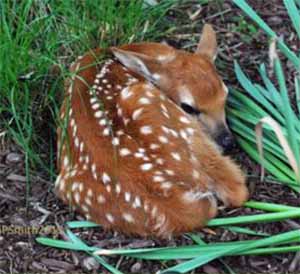
Doe and Fawn -pinterest

What a Mouthful: (Odocoileus virginianus)
In 1780, Eberhard August Wilhelm von Zimmerman, a naturalist, formally identified the white-tailed deer as a separate species. Zimmerman used the genus name Odocoileus because deer have hollow teeth (Gr. koilus). For the species name, he used the name of the state where it was first identified. Genus and species names are written in italics for two reasons. The first is, that many of these names come from Greek or Latin, and for clarity, words from other languages are italicized, such as, the word for hollow in Greek is (Gr. koilus), another example is in situ, or et al. Secondly, in science journals, genus and species are italicized by longstanding convention to aid spotting these names when skimming an article. For our purposes, let's call it the deer.
The deer is a mammal. Recall that because of the big brain, young mammals come through the birth canal relatively early, and require parental care. The young suckle at breasts that act as a post-partum umbilical. At 12 million, the deer is the second most numerous large wild mammal in the world. In contrast to wild mammals, domesticated mammals are the most numerous of all; cows number 1.5 billion, cats number 600 million. Sheep, pigs, and goats each number about 500 million, and dogs number about 400 million. Many smaller mammals are too numerous to count - rats, bats, mice, shrews, moles and others
Grow a Pair: Antlers
Each year, males grow a new pair of antlers which they will use for fighting over does in the autumn. Antlers grow out of the skull and are appendages, like an arm or ear, with bone, tissue, nerves, blood vessels and skin. In springtime, newly sprouted antlers look like and are called velvet. Velvet Grows at Speed! In yearlings, velvet grows about three inches per month, and about six inches per month in adults, making velvet one of the fastest growing tissues known. In contrast, the fastest growing human tissue is hair, about one half inch per month. Almost all adult males in the deer family (Cervids) grow annual antlers (mule deer, black-tailed deer, elk, moose). But, as often occurs, exceptions have evolved: in the caribou, or reindeer (Rangifer tarandus) both the males and females grow antlers, and, further, to extend the range of evolutionary possibility, water deer (image) have no antlers, but they do have long canine teeth. They are only found in China.
Chinese Water Deer (Hydropotes inermis) - wiki
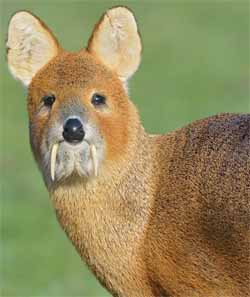
To the Point
Eight Point Buck - Charlie Pye, Trail Cam

The health and diet of the deer, as well as age, determines the number of points. In autumn, the males secrete testosterone, which hardens the antlers and thickens the neck. During this time, called "the Rut", is when bucks seek females recklessly. That means they don't look both ways when crossing, or look anywhere at all. They will fight for does. Two males will paw and posture, bellow and strut. But they don't crash together, rather they engage antlers and then try to twist the other one into submission. The winner gets the females. In late fall, the antlers are shed to be the regrown next spring. In contrast, and yet another evolutionary wiggle, horns are permanent, and are found on sheep, goats, bison and cattle.
Oh Deer, You Blend
Deer evolved over 3 million years ago in Florida (they are considered natives). When threatened, they use the age-old strategy of standing still. The ones that blended best survived.
See How They Blend
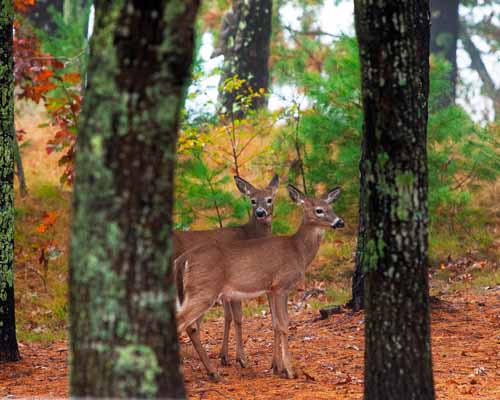
Deer in Summer Coat - Sharon Kujula

Deer in Winter Coat - Donna McBrien
Death and Life of the Deer
by Charlie Pye
The main drivers of the deer population are food availability, coyotes and humans. Deer prefer to graze grasses and other short plants, with the head vulnerably close to the ground. Coyotes, which evolved in grasslands predate more deer there than in the forest. Thus, the ecology of fear has driven deer into the forest, where they can browse the understory while holding a vigilant head up. Also, the three main natural deer predators of the forest, the bears, wolves and big cats have all been extirpated, thanks to humans. Further, humans have suppressed fires during the last 100 years, or so, and have abandoned farmland. Both activities mean more forest and more deer.
The Human Shield
In spring, does usually rear young within a few hundred yards of a house, as they know coyotes are averse to humans. Still, coyotes predate 40% or so of all fawns each year. Nonetheless, each doe may have up to ten fawns during her lifetime. The result is an overpopulation of deer. Estimates as to the number per square mile vary widely - from very few in developed areas to more than 50 per square mile in rural areas, and, in the extreme, some say up to eighty per square mile in forested areas.
Like a Deer in the Headlights: Culture Clash
Deer expect the dark to be dark, sudden headlights may freeze them in place. In contrast, humans don’t expect anything on the road without headlights. In summer, newly weaned fawns, unfamiliar with traffic - freeze. In autumn, during the rut, it is the bucks looking for does that get hit by cars. As per insurance claims, in 2021, 44,000 deer were hit by cars in Massachusetts. While coyotes and cars kill a lot of deer, so many are still left, that hunters in 2022-23 were allowed to take two bucks and an unlimited number of does. Hunters shoot about 14,000 deer each year.
And So to Dine
While deer are omnivores, they only occasionally eat small, rodent, crustaceans or other small animals. The bulk of their diet is plants, and they spend most of their time grazing and chewing their cud. Unlike carnivores, who eat protein-rich meat and therefore need relatively few meals, deer must eat a great deal of plant material to produce the same energy.
What a Grind.
Deer have a Mouthful of Teeth
Count the deer teeth in the image below.
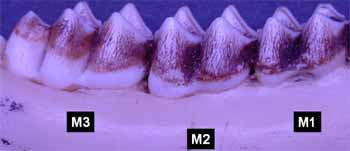
Deer Teeth at age 2½ Years - Susan T. Guynn
There are three molars: M3, M2 and M1. Deer have twelve of these bi-and tri-cuspid teeth, which they use to grind plant material. And that they do; grind, grind, grind all day long.
A Stomach for the Ages
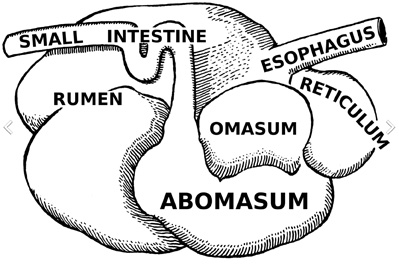 - wiki
- wiki
Deer have four stomachs. The food a deer browses goes to the rumen, or the first stomach, where it is stored. Later, the deer will regurgitate from the rumen into the mouth where the deer “chews its cud” (grind). Then they will re-swallow into the reticulum, stomach number two. Here the food is fermented by microbes in residence. Then the deer brings this mix back into the mouth and chews again (grind). This is re-swallowed into the omasum, the third stomach, where water is absorbed, and where much deer nourishment is derived from this rich blend of flora and microbes. Then it moves to the abomasum, the fourth stomach, which is the most similar to a human stomach for continued digestion and absorption. Finally, through 28 feet of intestines!
The Scoop on the Poop
Deer poop consists of small pellets that look like brown/green Raisinettes. And, even after all of that digestion, they may have bits of plant matter showing. Each pile of droppings may have up to 100 pellets, a little more than:
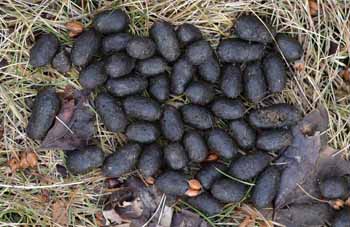
A Box of Raisinettes?
Deer Droppings - wikimedia commons
Grinding Toward Death
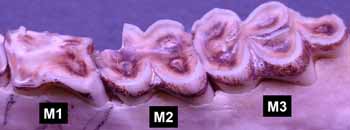
Deer Teeth at 7 Years-Susan T. Guynn
While most deer live about seven years on average, Myles Standish Forest deer may not live quite as long because the sand scooped up with plants abrades the teeth quickly. Starvation comes when the teeth wear out. But recall that each doe leaves about ten fawns and life goes on. Tale of the Tail: See How They Run
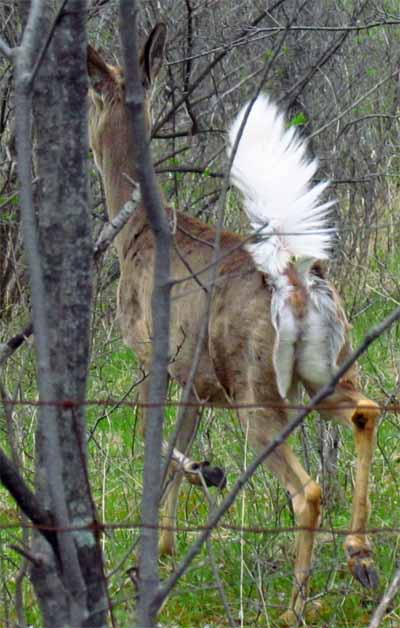
Luxurious White Tail -Wikimedia commons
As above, a deer will freeze in place to hide from predators. But when they get too close, the deer uses its namesake white tail. The deer is so named because the white tail is the most prominent feature and the way most people see a deer, with a white tail flashing in the distance. Many people wonder if such behavior attracts carnivores and gives away their position. But flashing their tail is called "flagging". Deer use flagging to alert other deer to danger, and also to confuse predators who may jump at the tail. But with the flag, the deer jumps, too, up to ten feet high, then bounds away at up to 40 miles an hour!
Because of these survival strategies, freezing in place, and if that fails, bounding away speed and multiple stomachs, deer can thrive in a variety of habitats, and can tolerate a wide range of temperatures and precipitation. Through several ice ages and all the carnivores life could muster, the deer are still here and all you may see is a pile of poop or a flash of white.
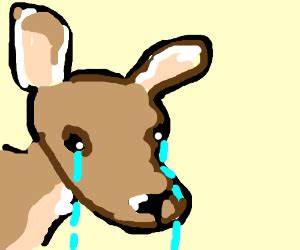
Goodbye Deer
All line drawings by: Patricia J. Cassidy